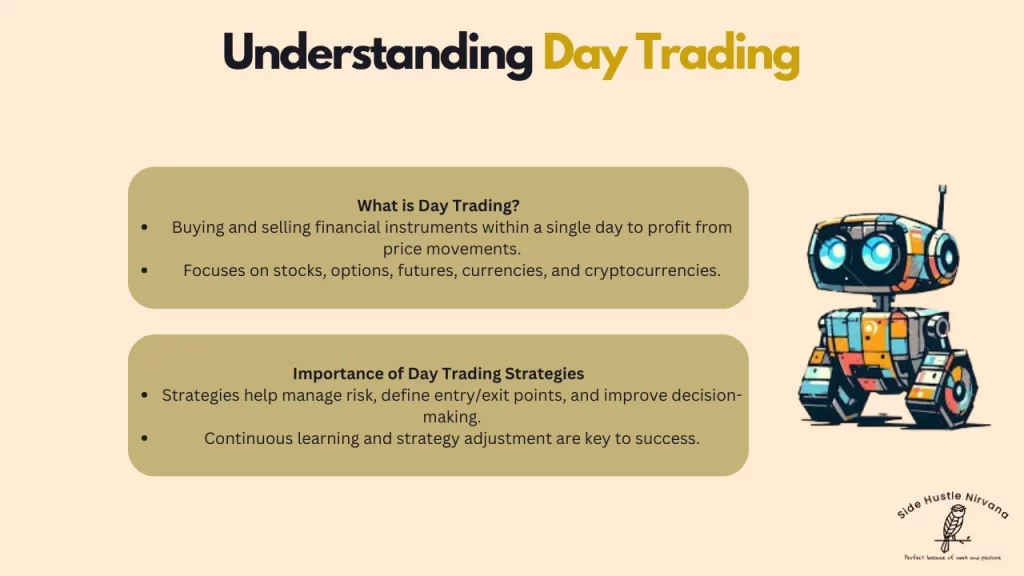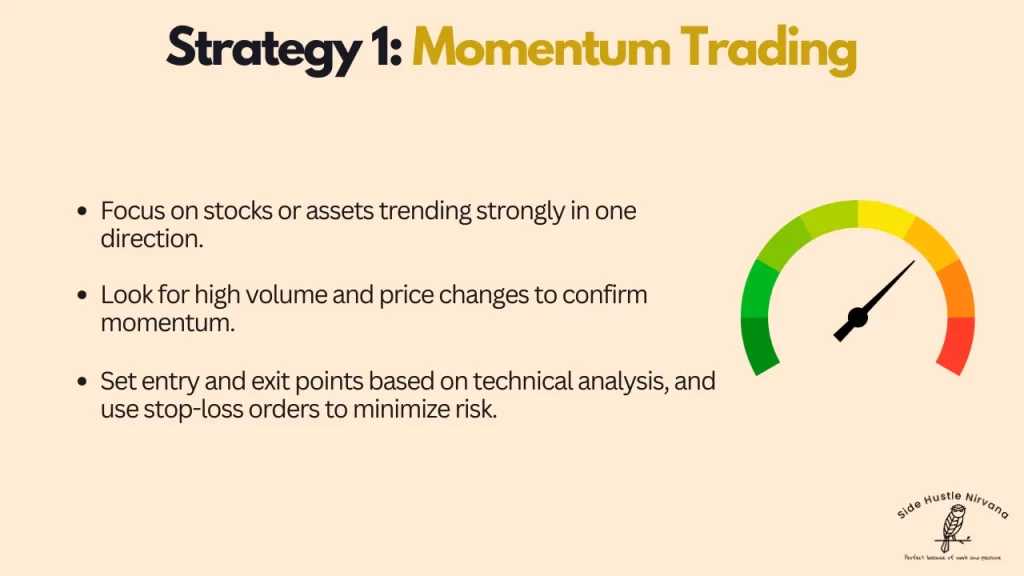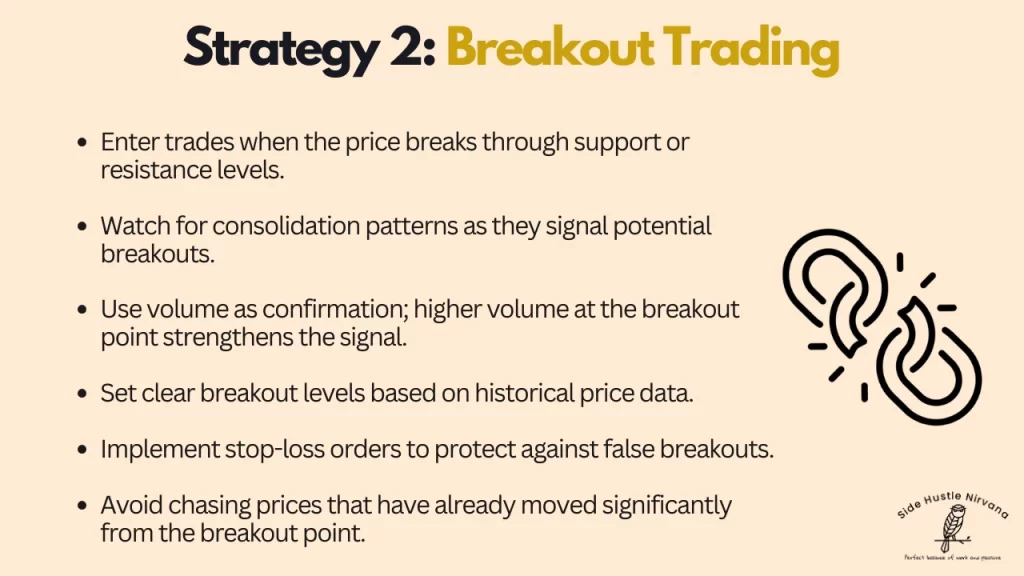5 Simple Day Trading Strategies for New Traders
Understanding Day Trading

What is Day Trading?
Day trading is a trading style that involves buying and selling financial instruments within a single trading day. This practice is often executed by individual traders who leverage quick price movements to generate profits. Unlike traditional investing, which can last for months or years, day trading requires participants to close all positions by the end of the trading session. This method helps avoid the risks associated with overnight price fluctuations.
Traders typically focus on stocks, options, futures, currencies, and sometimes cryptocurrencies to capitalize on their daily price volatility. They make decisions based on market trends, charts, and indicators rather than the fundamental value of a security. Given the nature of day trading, it requires discipline, strategy, and a good understanding of market dynamics. Many day traders also utilize advanced trading platforms that offer real-time data and analytics, allowing them to react swiftly to market changes. This technological edge can be a significant advantage, as it enables traders to execute trades at lightning speed, which is often essential in a market that can change in seconds.
The Importance of Day Trading Strategies
Having well-defined day trading strategies is crucial for traders, especially those who are new to this fast-paced environment. A strategy provides a systematic approach to trading that helps mitigate risks and optimize potential profits. It enables traders to make informed decisions based on analysis rather than emotional reactions.
Effective day trading strategies can vary from trader to trader, but they often encompass elements like risk management, entry and exit points, and criteria for trade selection. By adhering to a predefined strategy, traders can navigate the complexities of the market more effectively, improving their chances of success in the long run. Additionally, many successful day traders emphasize the importance of continuous learning and adaptation. The financial markets are dynamic, and what works today may not work tomorrow. Therefore, traders often review their performance, analyze their trades, and adjust their strategies accordingly to remain competitive. This iterative process not only enhances their skills but also fosters a deeper understanding of market behavior and trading psychology, which are vital components of successful day trading.
The Basics of Day Trading

Setting Up Your Trading Account
Before engaging in day trading, new traders must first set up a trading account. This account typically should be designated specifically for trading, distinct from personal or other investment accounts. Traders should choose a reliable brokerage platform that offers an intuitive interface, competitive fees, and robust trading tools.
When opening a trading account, consider the following steps:
- Research and select a broker that meets your needs.
- Complete the application process, which often includes identity verification.
- Deposit the minimum required funds to start trading.
- Familiarize yourself with the platform’s features, including order types and tools.
It’s also important to review the educational resources provided by your chosen broker. Many platforms offer tutorials, webinars, and demo accounts that allow you to practice trading without risking real money. This practice can help you build confidence and develop your trading strategy before you start making actual trades. Additionally, consider the importance of customer support; having access to knowledgeable representatives can be invaluable, especially when you encounter issues or have questions about your trades.
Understanding Trading Charts and Indicators
Charts and indicators are vital for day traders, as they provide essential information about price movements and market trends. Understanding how to read trading charts and utilize indicators can significantly enhance a trader’s decision-making process.
Traders often use various chart types, such as line charts, bar charts, and candlestick charts, to analyze price data. Each chart provides a different perspective on price behavior over specific periods, and they can assist traders in identifying patterns and trends. Additionally, indicators such as moving averages, RSI (Relative Strength Index), and MACD (Moving Average Convergence Divergence) can highlight potential buy and sell signals and help in gauging market momentum. For instance, candlestick charts are particularly popular among day traders due to their ability to convey more information than traditional line charts, including open, high, low, and close prices within a specific timeframe.
Moreover, it’s essential to understand the significance of volume in trading. Volume refers to the number of shares or contracts traded within a given period and can provide insight into the strength of a price movement. High volume often indicates strong interest in a stock, which can lead to more reliable price movements, while low volume may suggest a lack of conviction in the price direction. By combining chart analysis with volume indicators, traders can make more informed decisions and potentially increase their chances of success in the fast-paced world of day trading.
Strategy 1: Momentum Trading

The Concept of Momentum Trading
Momentum trading is a strategy that focuses on stocks or assets that are trending strongly in one direction. Traders employing this strategy aim to enter positions that are moving upward or downward, leveraging the existing momentum to secure profits. The idea is that once an asset is on the move, it may continue in that direction for some time.
This trading style often involves quick decision-making and the use of specific indicators to confirm momentum. Traders look for high volume and price changes, as these can indicate strong market sentiment and potential for continued movement.
How to Implement Momentum Trading
To successfully implement a momentum trading strategy, traders typically follow these steps:
- Identify stocks or assets with strong price movements, often using a screen for volatility.
- Monitor volume levels; increasing volume often confirms the validity of the price trend.
- Establish entry and exit points based on technical analysis.
- Use stop-loss orders to minimize potential losses if the trend reverses.
Strategy 2: Breakout Trading

Understanding Breakout Trading
Breakout trading involves entering a trade when the price of an asset breaks through a predetermined level of support or resistance. This strategy is based on the premise that once the price breaks these levels, it may continue to move significantly in that direction.
Traders often watch for breakouts from ranges where the price has been consolidating, as this can indicate potential volatility. By anticipating these breakouts, traders can position themselves to capitalize on rapid price changes.
Tips for Successful Breakout Trading
To increase the likelihood of success with breakout trading, consider these tips:
- Establish clear breakout levels based on historical price data.
- Use volume as a confirmation signal; higher volume at the breakout point can indicate strength.
- Implement stop-loss orders to protect against false breakouts.
- Remain disciplined and avoid chasing prices that have already moved significantly away from the breakout point.
Strategy 3: Reversal Trading

What is Reversal Trading?
Reversal trading is a strategy that seeks to take advantage of price reversals from established trends. Traders believe that once an asset has moved significantly in one direction, it may reverse direction and move the opposite way. This approach requires keen observation and understanding of market dynamics.
Identifying potential reversal points typically involves analyzing price patterns, support and resistance levels, and trends. The key is to enter a trade just before the price movement changes direction, offering the opportunity to profit from the shift.
Implementing Reversal Trading
Successful implementation of a reversal trading strategy involves:
- Identifying overbought or oversold conditions using indicators like RSI or Bollinger Bands.
- Looking for pattern formations such as head and shoulders or double tops/bottoms.
- Setting entry points near identified reversal levels and using stop-loss orders to manage risk.
- Being patient and waiting for confirmation of the reversal before entering a trade.
In conclusion, day trading can be an exciting yet challenging venture, especially for new traders. By understanding the fundamentals and applying these strategies—momentum, breakout, and reversal—traders can navigate the markets with greater confidence and improve their chances of success. Always remember that continuous learning and practice are key components of becoming a proficient day trader.







